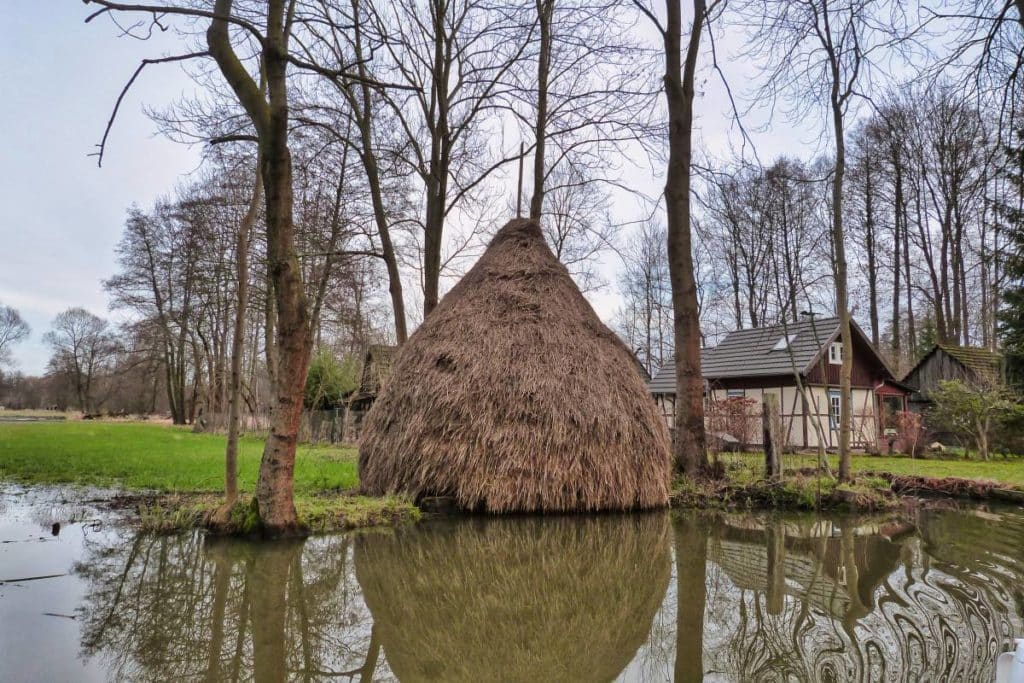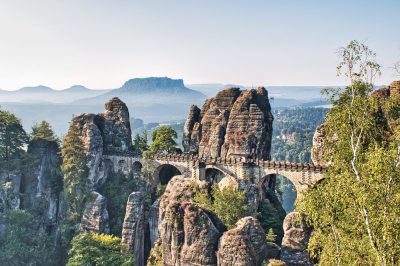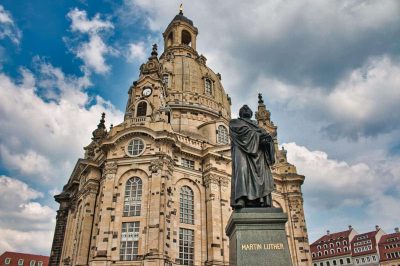Brandenburg is not only the largest of the “new” German states in terms of area. There is also a myriad of Brandenburg Germany sights. Because each region of the country is different and offers a different mix of culture and sights. Here is an overview what there is to see in the state of Brandenburg.
Brandenburg Germany sights on the Oder and Spree rivers
Lower Oder Valley National Park
The Lower Oder Valley National Park is one of the most beautiful nature reserves in eastern Germany. It extends along the entire lower reaches of the Oder River. Although the polders here are farmed in the summer. In winter, however, they are flooded, minimizing the risk of flooding. The national park is home to a number of animal and plant species that have become rare in Germany, such as the beaver, whooper swan, sedge warbler and oriole. On bike tours or guided hikes you can get to know this unique natural landscape better.
Eisenhüttenstadt
Once built in the 1950s in the GDR, the former Stalinstadt was a so-called socialist planned city. The city is one of the most important testimonies of socialist architecture in the former GDR. You can learn more about the development of the city, which once had more than 50,000 inhabitants and now has less than 25,000, in the local museum. In the streets of Eisenhüttenstadt you can still find many works of art from GDR times – from murals to fountains and sculptures. Thus, the city is also a kind of huge open-air museum.
Neuzelle Monastery
The Cistercian monastery of Neuzelle is a haven of Catholicism – and that in an otherwise formerly very Protestant, now rather atheistic area. The monastery complex is a true jewel of Baroque architecture. The nave of the monastery church is so magnificently decorated that one is almost surprised, after all, the churches in the area are usually very plainly furnished. Even though it was already secularized by the Prussian kings in the 19th century, monks have even been living in the complex again since 2018. Little by little, the monastery is to be revived as a religious place.
Seelower Höhen
The Seelow Heights were the site of the last major battle of World War II involving German troops in April 1945. It was the Nazis’ last senseless stand against the Soviet troops advancing on Berlin. At least 30,000 German soldiers and 80,000 Soviets died in the slaughter. It was followed by the capture of Berlin and the surrender of Hitler’s Germany within three weeks. Today, a museum and the huge war gravesite commemorate the Battle of Seelow Heights.
Sights in Lusatia

Spreewald
The Spreewald (“Spree forrest”) is one of the most beautiful cultural landscapes in Germany. Thatched houses, local specialties, Sorbian costumes and postmen on canoes: the Spreewald is unique in Germany. The best way to explore the Spreewald is on a boat trip or to rent a boat yourself to explore the countless canals and the small villages. In between you can stop at restaurants and stalls and enjoy many other delicacies besides the famous Spreewald gherkins.
Cottbus and Park Branitz
Cottbus as a center in South Brandenburg has not only an exciting art museum to offer. Here you will also find one of the most beautiful parks in the east. The late work of Count Pückler is an English garden. He designed it also to find his last resting place here. Thus, he lies here in an earth pyramid designed by him, which is also the landmark of the park.
Twin city Guben/Gubin
Once a city located on both sides of the Neisse River, today it consists administratively two cities. This is because after the German defeat in WW II, the Oder-Neisse line became the new border of Germany. Thus, some cities were divided along the rivers. In Guben, the division was more significant than elsewhere, because the old city center was now in Poland. Today, due to the opening of the border and the Schengen Agreement, you can easily walk through both cities and visit the ruins of the main church on the Polish side and climb the tower. Many cross-border events also take place in Guben/Gubin.
Sights in Fläming and Havelland
Brandenburg
Brandenburg is not only a federal state. There is also the city that gave the name to the region. And it is also one of the most beautiful Brandenburg Germany sights. Because besides a lot of water with excursion possibilities by boat, you should also see the old town.
Beelitz with sanatoriums and treetop trail
The sanatoriums of Beelitz were originally founded at the beginning of the 20th century as sanatoriums for lung patients. Thus, tuberculosis patients and asthmatics were treated here. During the Soviet occupation, the sanatoriums served as the largest hospital of the Soviet Army outside the Soviet Union. The Lenin monument and many pieces of Soviet equipment in the dilapidated buildings still bear witness to this today. A treetop trail was opened on the site in 2015, which many thousands of visitors climb every year.
Flaeming-Skate
The Flaeming Skate is unique in Germany. This is because a total of 230 kilometers of network of paths with fine asphalt has been created here in the relatively flat landscape of the Fläming region in southwestern Brandenburg. The paths can be used by cyclists, but also by inline skaters and rollerbladers. They also connect the main sights in the region.
Ziesar castle
Ziesar castle was a bishop’s castle and secondary seat of the bishop of Brandenburg. From the keep you have a fantastic view over the surrounding area. The medieval wall paintings are among the most beautiful in Brandenburg. And in the Museum of Brandenburg Church and Cultural History of the Middle Ages you can learn more about the church and religion.
Sights in Potsdam
Potsdam was the residence city of the Prussian kings and all important Prussian kings spent most of their time here. The many palaces and the rich history of the city can fill several days of visiting. However, the following sights in Potsdam are must-sees:
Sanssouci Castle
Once commissioned by Frederick the Great, Sanssouci was built from 1745 to 1747 according to plans by architect Georg Wenzeslaus von Knobelsdorff. Frederick used the palace as a summer residence, met the philosopher Voltaire here and enjoyed his life here. It is one of the major works of the German Rococo period and can hardly be surpassed in its splendor. Sanssouci Park should also be visited and is one of the most beautiful parks in Germany.
Dutch Quarter
Planned under Frederick Wilhem I and designed by Amsterdam architect Jan Bouman, the Dutch Quarter was intended to attract mainly Dutch people to Potsdam. Some of them did come. Today, however, there are probably none of them left in the city. Nevertheless, the quarter, which fell into decay during GDR times, has been restored in the last three decades, also with the help of the Dutch royal family. Today you can find many small stores and restaurants and watch craftsmen at work.
Forbidden city of the Soviets
After the end of World War II, more than 500,000 soldiers and civilians were temporarily stationed in the GDR as part of the Allied occupation of Germany. And, of course, these troops were also under surveillance by the KGB and military intelligence. The heart of this surveillance was in the middle of Potsdam in the so-called Forbidden City. You can visit this today on guided tours and among other things also the former KGB prison, which also existed in Potsdam independently of the Stasi prison.
Cecilienhof Palace
Built as the last residential palace by Kaiser Wilhelm II for his son Crown Prince Wilhelm and his wife Cecilie, Cecilienhof Palace has become particularly famous as a meeting place for Allied leaders. It was here that U.S. President Harry S. Truman, British Prime Minister Clement Attlee and Soviet dictator Josef Stalin met in 1945 after Hitler’s Germany surrendered and sealed Germany’s fate. At the museum, you’ll learn all about the Potsdam Conference and can visit the meeting room with table and the other original sites of this conference that was so important for the world.
Sights in Barnim and Uckermark
Chorin Monastery
Chorin Monastery is one of the most beautiful monastery complexes in Brandenburg and an important testimony of the Nordic Brick Gothic. Chorin was founded as a Cistercian monastery and secularized in the 16th century. There are 14th century murals to be seen to this day. The architecture of the ensemble is breathtaking and definitely gives enough material for your Instagram account.
Forest settlement Wandlitz
The so-called Waldsiedlung, also known as Waldsiedlung Wandlitz, was home to the leaders of the GDR regime. From Honecker to Mielke and Stoph – they all had a house here. Even if the settlement seems almost modest by today’s standards, the SED bigwigs not only had a swimming pool and a sauna here, but also had access to all kinds of fruits and vegetables and Western products through their own sales outlet. The whole settlement was also secured by guard posts and protective walls. Today you can easily drive here and visit the settlement, where now ordinary people live.
Niederfinow ship lift
The Niederfinow ship lift is the oldest ship lift in the world still in operation. It began its work in 1934 and is one of the masterpieces of German engineering. On the Oder-Havel Canal, ships overcome a height difference of 36 meters with the help of the ship lift. You can explore this technical masterpiece on a circular route and on guided tours.
Grumsin beech forest
Like the Hainich in Thuringia, the Grumsin beech forest is a UNESCO World Heritage Site. In this forest, which has now been largely restored to its natural state, you can explore the biodiversity of the region. There are not only enchanted moors, but also many fallen trees and overgrown clearings. A beautiful walk to simply escape from everyday life.
Sights in the Prignitz and the Ruppiner Land
Rheinsberg
Rheinsberg is one of the most attractive small towns in Brandenburg. Not only the cute old town attracts visitors. Rheinsberg Castle is also a magnet for many tourists. Frederick the Great once resided here. But Rheinsberg is especially famous as a retreat for Kurt Tucholsky. The great writer of the Weimar Republic immortalized the town in his book “Rheinsberg – Picture Book for Lovers”. Today, the Kurt Tucholsky Museum of Literature commemorates this episode.
Wittenberge
When Singer, a sewing machine manufacturer from New York, built a factory here in 1903, the town grew rapidly. The largest free-standing clock tower in Europe, which was built for Singer, still bears witness to this time. The old town with its stone gate from 1297 and the castle, which is now a town museum, is a good place to stroll. The site of the oil mill is also worth a visit. Here you can see and experience not only a restaurant with a brewery, but also lofts, a spa, a lido and a diving tower.
Plattenburg
The oldest existing moated castle in northern Germany was once home to the Havelberg bishops, who used it as a summer residence. Today you can visit the castle and see the knights’ hall with its beautiful fireplace, the brewery and guesthouse and the castle tower. In summer, the Plattenburgspektakel takes place here, a medieval festival with all kinds of historical performances and booths.
Stork village Rühstädt
The village of Rühstädt in Prignitz is a real stork metropolis. The village that attracts many storks every year. On average, at least 30 pairs breed here every summer and raise their offspring. There is plenty of food for them in the surrounding Elbe meadows. In the visitor center you can learn everything about the storks in Rühstädt and the project of the stork village.
- Fontane, Theodor (Author)



